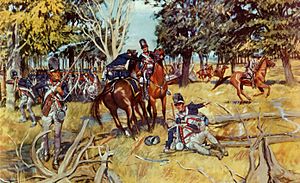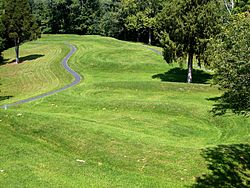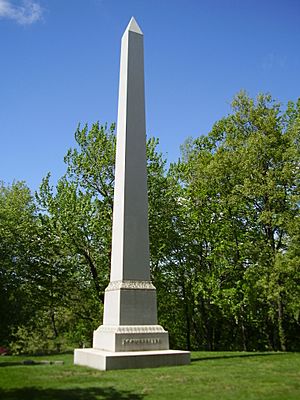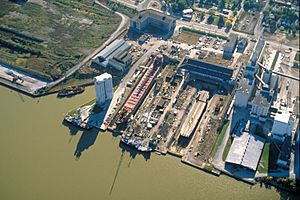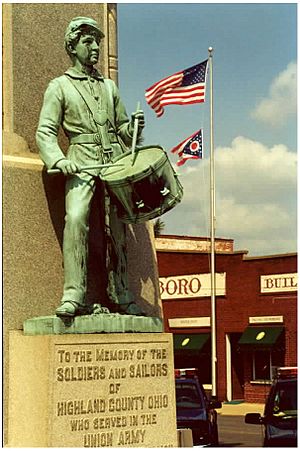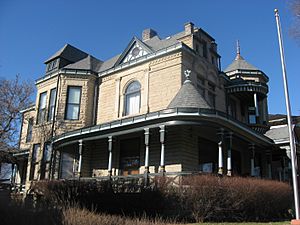History of Ohio facts for kids

The history of Ohio as a state began on March 1, 1803. It became the 17th state to join the United States. Before this, the area was part of the Northwest Territory. The name "Ohio" comes from the Ohio River. The Iroquois people called it O-y-o, meaning "great river."
For hundreds of years before Europeans arrived, Native American tribes lived in Ohio. Some of these were the Hopewell "mound builders." Later, the Iroquois took over the area. In the 17th century, French explorers from Canada were the first Europeans to reach the Ohio River.
By the mid-1700s, French and American fur traders were active in Ohio. They traded with Native American tribes. After the American Revolutionary War, American settlers began moving into the Ohio Country. The U.S. Congress made sure that slavery was not allowed in the Northwest Territory. This meant Ohio and other states formed from this territory would be "free" states.
Ohio's population grew quickly after the Northwest Indian War ended. This war brought peace to the Ohio frontier. On March 1, 1803, Ohio officially became a state. Many early settlers came from New England, New York, and Pennsylvania. People from the southern U.S. settled along the Ohio River. Those from New England, especially near Cleveland, supported modern ideas, public education, and anti-slavery efforts. During the American Civil War, Ohio strongly supported the Union.
After the Civil War, Ohio became a major industrial state. Ships on the Great Lakes brought iron ore and other goods. Railroads also helped move products. In the late 1800s and early 1900s, industries created many jobs. This attracted hundreds of thousands of immigrants from Europe. Later, people from the American South, including rural white people from Appalachia and African Americans in the Great Migration, moved to Ohio. They sought to escape unfair laws and find better opportunities.
Ohio's cities became very diverse with new traditions, foods, and music. Ohio's factories were key to America's industrial strength in the 20th century. Later, industries like steel and railroads slowed down. This caused Ohio to lose many jobs. In the 21st century, Ohio's economy has shifted to service industries, like medicine and education.
Contents
Ancient People of Ohio
Long ago, different groups of Native Americans lived in Ohio. Around 800 BC, the Adena culture appeared. They were known as "mound builders" because they built thousands of burial mounds. Many of these mounds can still be seen today.
After the Adena, the Hopewell culture (around 100 to 400 CE) built amazing mounds and earthworks. Some of these are still standing at Hopewell and Newark. They used these structures as observatories and for special ceremonies. The Fort Ancient culture also built mounds, including some shaped like animals, called effigy mounds.
The Serpent Mound in Adams County, Ohio is the largest effigy mound in the United States. It's one of Ohio's most famous landmarks. It might have been built by the Fort Ancient people. In southern Ohio alone, archaeologists have found 10,000 mounds used for burials. They've also found 1,000 earth-walled enclosures. One huge enclosure is about 3.5 miles around!
Items found in these mounds show that these ancient people traded far and wide. They used obsidian from Yellowstone National Park, copper from the Great Lakes, mica from the Appalachians, and shells from the Gulf of Mexico. This shows a huge trading network across the continent.
When Europeans arrived, they traded with Native American tribes for furs. The Iroquois Confederacy, from the New York area, ran out of beaver and other game. So, they started wars, known as the Beaver Wars, in the 1650s. They nearly destroyed the Erie tribe near Lake Erie. After this, the Iroquois claimed Ohio and West Virginia as their hunting grounds. For many years, the land was almost empty.
French, British, and Native Americans
In the 1600s, the French were the first Europeans to explore the area known as Ohio Country. In 1663, it became part of New France. Robert La Salle explored northeastern Ohio in 1669. The French built Fort Miami near present-day Toledo, Ohio in 1680.
During the 1700s, the French set up trading posts to control the fur trade. These posts connected to their settlements in Canada and along the Mississippi River.
By the 1730s, more Native American groups moved to Ohio. These included the Delaware and Shawnee from the east. The Wyandot and Ottawa came from the north. The Miami lived in western Ohio. The Mingo tribe formed from Iroquois who moved west.
Christopher Gist was one of the first English explorers to write about Ohio in 1749. When British traders like George Croghan started trading in Ohio, the French and their Native American allies drove them out. In 1752, the French attacked the Miami town of Pickawillany. The French then began to control the Ohio Valley militarily in 1753.
Seven Years' War in Ohio
By the mid-1700s, British traders were competing with the French. The British had a trading post called Loramie's Fort. The French attacked it in 1752. The struggle for control of Ohio helped start the Seven Years' War in Europe, also known as the French and Indian War in America. George Washington was involved in early battles in Ohio, including the Battle of Fort Necessity in 1754.
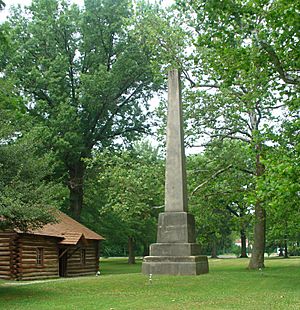
In 1763, the Treaty of Paris gave the Ohio Country to Great Britain. This period was often filled with conflict between different tribes.
British Rule and Revolution
British military presence led to Pontiac's War in 1763. Ohio Native Americans fought in this war until a truce was made. Another military trip into Ohio in 1774 ended Lord Dunmore's War.
Ohio in the American Revolution
During the American Revolutionary War, Native Americans in Ohio were divided. Some, like Shawnee leader Blue Jacket, sided with the British. Others, like Shawnee leader Cornstalk, wanted to stay friendly with the American colonists. However, American frontiersmen sometimes attacked all Native Americans, whether they were friendly or not. Cornstalk was killed by American soldiers.
One sad event was the Gnadenhutten massacre in 1782. American militia killed many peaceful Moravian Native Americans in Ohio.
After the American victory, the British gave up their claims to Ohio and lands west to the Mississippi River. Between 1784 and 1789, the states of Virginia, Massachusetts, and Connecticut gave their land claims in Ohio to the U.S. Congress. However, Virginia and Connecticut kept some special areas, known as the Virginia Military District and Connecticut Western Reserve.
Becoming a Territory and State
In 1787, the United States created the Northwest Territory. Ebenezer Sproat helped survey land for the Ohio Company of Associates. On April 7, 1788, Sproat and other pioneers, led by Rufus Putnam, arrived at the Ohio River and Muskingum River. They founded Marietta, Ohio, the first permanent American settlement in the Northwest Territory. Marietta was founded by people from New England.
Colonel Sproat was a tall and impressive figure. The local Native Americans called him "Hetuck," meaning "eye of the buck deer" or "Big Buckeye." Historians believe this is how Ohio got its nickname, the Buckeye State.
Other companies helped settle different parts of Ohio. Many people moved from New York and New England, looking for land. They traveled by wagon or stagecoach on old Native American paths. Some also used barges on the Mohawk River.
Native Americans resisted American settlement in the Northwest Indian War. General Anthony Wayne defeated them at the Battle of Fallen Timbers in 1794. In 1795, the Treaty of Greenville made Native Americans give up much of present-day Ohio to the United States.
The U.S. Congress made slavery illegal in the Northwest Territory. This meant Ohio would be a "Free State." As Ohio prepared for statehood, the Indiana Territory was created. This made the Northwest Territory about the size of present-day Ohio.
Ohio Becomes a State
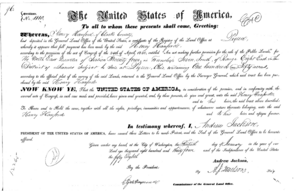
By December 1801, Ohio's population reached 45,000. Congress decided Ohio was ready to become a state. They passed the Enabling Act of 1802, which set out the steps for Ohio to join the Union. Ohio residents held a meeting to write their constitution. They used ideas from other states and chose not to allow slavery.
On February 19, 1803, President Jefferson signed the act approving Ohio's boundaries and constitution. Ohio became the 17th state.
Ohio in the War of 1812
Ohio was very important during the War of 1812. It was on the front lines of the fighting in the West. Several important battles took place in Ohio, both on land and on Lake Erie.
Ohio's Industrial Growth
Throughout the 1800s, Ohio quickly developed industries alongside its farms. One of the first iron factories opened near Youngstown in 1804. By the mid-1800s, Ohio had 48 iron furnaces. The discovery of coal helped the steel industry grow. By 1853, Cleveland was the third-largest iron and steel producer in the country.
Ohio became a leader in steel production. Companies like Republic Steel and Armco (now AK Steel) were founded there. Cincinnati became known as "Porkopolis" for its meatpacking industry. By 1850, it was the third-largest manufacturing city in the U.S.
Factories across the state made farming machines. Columbus was called the "Buggy Capital of the World" because of its many carriage makers. Dayton became a technology hub with the National Cash Register Company. For about ten years in the late 1800s, Ohio was the top producer of crude oil in the country. Cleveland became the "oil capital of the world" and was home to Standard Oil, founded by John D. Rockefeller, the world's first billionaire.
Many famous companies started in Ohio. Herbert H. Dow founded the Dow Chemical Company in Cleveland in 1895. Frank Seiberling named his rubber company after Charles Goodyear; it's now Goodyear Tire and Rubber Company. Harvey S. Firestone started Firestone Tire and Rubber Company. Benjamin Goodrich also started a rubber company in Akron in 1870, which became the Goodrich Corporation.
By the late 1800s, Ohio was a global industrial center. Its natural resources, like salt, iron ore, timber, and coal, helped this growth. By 1908, Ohio had over 9,500 miles of railroad tracks connecting mines, oil fields, and industries.
Ohio's Innovations
Ohio has been a place of many inventions. William Procter and James Gamble started Procter & Gamble, making famous products like Ivory soap. Michael Joseph Owens invented the first semi-automatic glass-blowing machine.
The Wright brothers invented the first airplane in Dayton. Charles F. Kettering invented the first automatic starter for cars. The Battelle Memorial Institute helped develop xerography, leading to the company Xerox. At Cincinnati's Children's Hospital, Albert Sabin created the first oral polio vaccine.
In 1955, Joseph McVicker tested a wallpaper cleaner that became Play-Doh. The Tappan Stove Company created the first microwave oven for homes. James Spangler invented the first successful portable vacuum cleaner, which he sold to The Hoover Company.
African American inventors in Ohio also made important contributions. Garrett Morgan invented an early traffic light. Frederick McKinley Jones invented refrigeration devices for transportation. In Cincinnati, Granville Woods invented the telegraphony. John P. Parker invented a machine for processing tobacco.
Building Ohio's Infrastructure
Ohio's economy grew because it built good transportation systems. By the late 1810s, the National Road connected Ohio to the East Coast. The Ohio River helped farmers ship their goods south. The Erie Canal in the 1820s allowed Ohio businesses to ship goods through Lake Erie to the East Coast. Later, the Ohio and Erie Canal connected Lake Erie with the Ohio River. This gave Ohio full water access across the United States. Other canals, like the Miami and Erie Canal, also helped.
The first railroad in Ohio, the Erie and Kalamazoo Railroad, was completed in 1836. It connected Toledo with Adrian, Michigan. The state also helped fund railroad construction. The Little Miami Railroad connected Cincinnati with Springfield, Ohio. The Baltimore and Ohio Railroad connected Ohio to the East Coast.
Ohio's central location and good transportation system made it a key hub for travel and trade. This gave the state a head start during the industrial growth of the late 1800s.
Many ports grew along Lake Erie, including Port of Ashtabula, Port of Cleveland, and Port of Toledo. The Port of Cincinnati was built on the Ohio River.
After air travel became common, Ohio became a key route for flights. The first commercial cargo flight happened between Dayton and Columbus in 1910. Cleveland Hopkins International Airport, built in 1925, had the first air traffic control tower. The Interstate Highway System in the mid-1900s further made Ohio a transportation center.
Growth of Cities and Businesses
With rapid industrial growth, Ohio's population grew from 2.3 million in 1860 to 4.2 million by 1900. By 1920, nine Ohio cities had populations of 50,000 or more.
This growth led to many new businesses, including banks and insurance companies. Major banks like National City Corporation (now part of PNC Financial Services) and KeyBank started in Ohio. Fifth Third Bank and Bank One also began there. Insurance companies like American Financial Group and Nationwide Mutual Insurance Company were founded in Ohio.
Big retail companies also emerged. Kroger, founded in Cincinnati in 1883, is now one of the largest grocery chains. Federated Department Stores (now Macy's) started in Columbus in 1929. The Sherwin-Williams Company was founded in Cleveland in 1866.
Other well-known businesses include Frisch's Big Boy (opened 1905 in Cincinnati) and American Electric Power (founded 1906 in Columbus). The National Football League actually started in Canton, Ohio, in 1922 as the American Professional Football Association. The Cleveland Clinic, founded in 1921, is now a world-leading medical center.
Education in Ohio

Education has been important in Ohio since its early days. In 1821, the state passed a tax to fund local schools. In 1825, Ohio created a public school system, funded by a property tax.
School districts were formed. By 1838, the state provided $200,000 for public schools. The first middle school in the nation, Indianola Junior High School, opened in Columbus in 1909. McGuffey Readers, a popular textbook series, came from Ohio.
Many universities and colleges were founded early on. Ohio University in Athens (1804) was the first university in the Northwest Territory. Others include Miami University (1809), the University of Cincinnati (1819), and Ohio State University (1870).
The first dental school in the U.S. was in Bainbridge, Ohio. The Ohio School for the Blind was the first of its kind in the country. In 2007, the University System of Ohio was created, becoming the nation's largest public higher education system.
Ohio's Social History
Religion and Community
In the 1800s, rural Ohio was known for its many different religions and its tolerance. No single religion dominated. Germans brought Lutheran and Reformed churches, plus smaller groups like the Amish. People from New England brought Presbyterians and Congregationalists. Religious revivals led to the growth of Methodist, Baptist, and Christian churches.
Many colleges were founded by different religious groups. By the 1840s, German and Irish Catholics moved into cities. Later, more Catholics from eastern and southern Europe arrived. Jewish and Eastern Orthodox communities also grew. African Americans built their own Baptist and Methodist churches in cities.
During the early 1900s, Washington Gladden was a leader of the Social Gospel movement in Ohio. He fought for things like Prohibition and fair treatment for workers. He also spoke out against racial violence.
Diverse People of Ohio
Early Ohio culture was shaped by Native American groups, though their presence changed after 1790. Northeastern Ohio was settled by "Yankees" from Connecticut, New York, and Pennsylvania. The Connecticut Western Reserve became a center for new ideas and reforms. These settlers were often educated and open-minded.
Other early pioneers came from states like Pennsylvania and Virginia. Some settled on land given to soldiers. The Harrison family of Virginia became important in Ohio, with William Henry Harrison becoming Ohio's first U.S. President. His 1840 campaign celebrated the pioneer spirit of Ohio.
Before 1850, Ohio was mostly farms. Men were seen as the providers, focusing on making money from farming. Women managed the home, cared for children, and tended gardens. They also formed social groups, often through churches, and helped each other with child-rearing.
Many German Americans arrived from Pennsylvania and Germany. They kept their German language and traditions. Their villages included German Village in Columbus and Gnadenhutten. The way people speak in many parts of Ohio, called the Midland dialect, came from German Americans from Pennsylvania.
African Americans using the Underground Railroad came to Ohio, some settling, others passing through to Canada. Universities and colleges opened, leading to a more educated society.
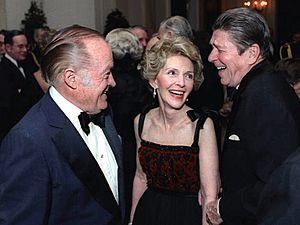
In the late 1800s, Ohio became even more diverse. New immigrants came from Europe, including Ireland and Germany. The Forty-Eighters from Central Europe settled in Cincinnati's Over-the-Rhine neighborhood. Irish immigrants settled across the state. Later, immigrants from Russia, Italy, Poland, and other countries arrived. Around the early 1900s, rural southern European Americans and African Americans moved north for better jobs.
Ohio's mines, factories, and cities attracted many Europeans. Irish Catholics helped build canals, railroads, and streets in the 1840s and 1850s. After 1880, coal mines and steel plants attracted families from southern and eastern Europe.
Immigration slowed during World War I, allowing ethnic communities to become more "Americanized." After 1965, immigration increased again, with many new arrivals from Asia and Mexico.
Popular Culture in Ohio
As industries grew, Ohio's culture changed. Sports became popular. The Cincinnati Reds became one of the first professional baseball teams in 1869. Amusement parks like Cedar Point opened in 1870. Theaters, restaurants, and saloons also became common. Famous theaters like Playhouse Square Center in Cleveland and the Ohio Theatre in Columbus hosted many performers.
The Roaring Twenties brought Prohibition, bootlegging, and speakeasies. The swing dance culture also became popular.
Depression Years and Arts
The Great Depression hit Ohio hard in the 1930s. During this time, the Superman character was created by Cleveland residents Jerry Siegel and Joe Shuster. Superman often fought against the Nazis in his comics.
Many artists and writers from Ohio became famous, often moving to Hollywood. These included "king of the cowboys" Roy Rogers, artist Roy Lichtenstein, and writer Zane Grey. Alan Freed hosted the first live rock 'n roll concert in Cleveland in 1952. Ohio also produced famous musicians like Dean Martin and Doris Day.
Five Academy Award-winning films were partly produced in Ohio, including Terms of Endearment and Silence of the Lambs.
Ohio in the Civil War
During the American Civil War (1861-1865), Ohio was very important. It provided many soldiers, military leaders, and supplies to the Union Army. Ohio was the third most populated state in the Union. It raised almost 320,000 soldiers, more than any state except New York and Pennsylvania. Nearly 7,000 Ohio soldiers died in the war.
Several important generals were from Ohio, including Ulysses S. Grant, William T. Sherman, and Philip H. Sheridan.
Only two small battles were fought in Ohio itself. Morgan's Raid in 1863 caused alarm among the people. Ohio troops fought in almost every major campaign of the war.
Prison Camps in Ohio
One important Civil War site in Ohio is Johnson's Island, in Sandusky Bay. It was a prison camp mainly for Confederate officers. Over 15,000 Confederate soldiers were held there. The island has a cemetery where about 300 men are buried.
Camp Chase Prison in Columbus was another Union Army prison. There was a plan for prisoners to revolt in 1863, but it never happened.
Veterans and Their Legacy
Ohio has been involved in many wars throughout its history. Veterans have always been a strong force in the state. The Grand Army of the Republic, an organization for Civil War veterans, was very influential. The Veterans of Foreign Wars (VFW) was founded in Columbus in 1899.
Ohio has produced 319 Medal of Honor recipients, including the first one, Jacob Parrott. The state created the Ohio Veterans Home in Sandusky in 1886 to help soldiers in need. Ohio also provides free college tuition to any veteran who wants to attend its colleges.
Ohio Today
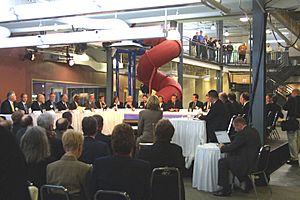
Today, Ohio continues to be a global center. Modern businesses and industries are found across the state. Immigrants from all over the world still come to Ohio. In 2008, about 436,640 foreign-born residents lived in Ohio. Ohio's economy is one of the largest in the world.
Ohio is the 7th most populated state in the U.S. It's known as the "fuel cell corridor" and is part of the "Green Belt" due to its growing renewable energy sector. Although Ohio faced job losses in manufacturing and the Great Recession, its economy began to recover in the early 2010s.
Ohio is very important in modern presidential elections. It has signed agreements with other states and Canadian provinces for cooperation. It has also been involved in disagreements with southern U.S. states over jobs.
Ohio's transition into the 21st century is shown by the Third Frontier program. This program, started by Governor Bob Taft, helps advanced technology industries grow. It has been very successful, attracting new high-tech companies and creating many jobs. In 2010, it won an award for economic development.
Ohio's cities are hubs for modern industry. Toledo is a national solar center. Cleveland is a research hub for regenerative medicine. Dayton is an aerospace and defense hub. Akron is still known as the "rubber capital of the world." Columbus is a technology research and development hub, and Cincinnati is a major trade center.
Ohio was hit hard by the Great Recession, losing many jobs and facing many home foreclosures. However, by 2010, the state's economy was showing signs of recovery.
In the 2000 and 2004 presidential elections, Ohio was a key "battleground" state. It played a crucial role in electing U.S. President George W. Bush.
Ohio's sports teams are among the nation's best. The Ohio State University football team has won national championships. The Cincinnati Reds won the World Series in 1990. The Cleveland Cavaliers won the NBA Finals in 2016.
In 1995, the Rock and Roll Hall of Fame museum opened in Cleveland. It celebrates Ohio's role in music history, including hosting the first live rock 'n roll concert in 1952.
Ohio's schools are highly ranked. In 2010, its schools were ranked #5 in the country by Education Week. Ohio has also contributed over 200,000 soldiers to recent wars, continuing its military legacy.
Images for kids
-
An artist's idea of the Fort Ancient period SunWatch Indian Village in Dayton, Ohio.
-
A map of the original Ohio Country.
-
This image shows General Rufus Putnam and the first settlers arriving at what would become Marietta, Ohio in 1788.
-
Rufus Putnam. This portrait is in the collection of Independence National Historical Park.
-
Campus Martius was named after a place in Rome. This site, including the Rufus Putnam House, is now part of the Campus Martius Museum in Marietta, Ohio.
-
This monument to the pioneers of Ohio is in Muskingum Park, Front St., Marietta, Ohio.
-
Entertainer Bob Hope was an immigrant from Britain who grew up in Cleveland.



